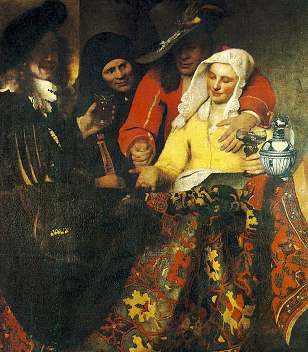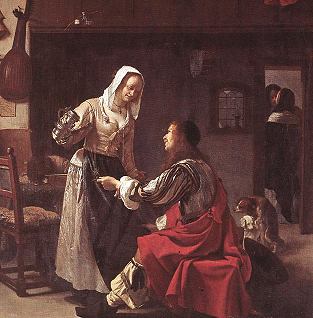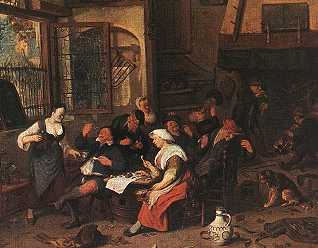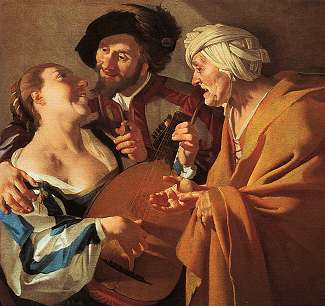Inside the Bourgeois Tavern
The Embarrassment of Riches by Simon Schama
 Few
of these establishments were brothels in the modern sense of being places where
customers came specifically for sex and completed the transaction on the premises.
More commonly, client and prostitute would meet at a musico, a place of drinking
and entertainment and dancing known for its girls, and run by a procuress-cum-hostess.
Gaming-cards, backgammon or dice-was also an important part of the recreation,
so that the hostess profited directly from liquor and gambling and indirectly
from sex by charging the girls a rate for the use of her premises to make their
contacts and for their out-lodgings (about twenty-five stuivers, or a higher
rate of about four guilders if they actually boarded with her). Whether the
girls lived in or out, though, they were very definitely the creatures of the
procuress, usually an ex-whore herself who had saved enough to go into the entrepreneurial
side of the trade. As in all the great metropolitan centers of Europe in the
early modern period, this was almost exclusively a female-dominated profession.
The exceptions seem only to have been men like Mouring, who were in the business
of supplying traveling whores – mobile troops – for fairs and kerrnisses
around the country and who followed in the train of quacks, peddlers, Gypsy
fortune tellers, and acrobats. The urban procuresses flourished, in effect,
through a diversified array of semi-criminal activities: receiving stolen goods,
smuggling – salt seems to have been a specialty – organized music
and dance entertainment, drink and tobacco supplies and, of course, sexual procurement.
The girls were indebted to the procuress, not just for food and board as well
as their share of earnings from sex, but for the extravagant dress that was
thought to be indispensable for the job. In some cases the procuress supplied
needed shelter and security to girls who were a long way from their rural birthplaces
or from towns in Germany or Danish Jutland. But in the
Few
of these establishments were brothels in the modern sense of being places where
customers came specifically for sex and completed the transaction on the premises.
More commonly, client and prostitute would meet at a musico, a place of drinking
and entertainment and dancing known for its girls, and run by a procuress-cum-hostess.
Gaming-cards, backgammon or dice-was also an important part of the recreation,
so that the hostess profited directly from liquor and gambling and indirectly
from sex by charging the girls a rate for the use of her premises to make their
contacts and for their out-lodgings (about twenty-five stuivers, or a higher
rate of about four guilders if they actually boarded with her). Whether the
girls lived in or out, though, they were very definitely the creatures of the
procuress, usually an ex-whore herself who had saved enough to go into the entrepreneurial
side of the trade. As in all the great metropolitan centers of Europe in the
early modern period, this was almost exclusively a female-dominated profession.
The exceptions seem only to have been men like Mouring, who were in the business
of supplying traveling whores – mobile troops – for fairs and kerrnisses
around the country and who followed in the train of quacks, peddlers, Gypsy
fortune tellers, and acrobats. The urban procuresses flourished, in effect,
through a diversified array of semi-criminal activities: receiving stolen goods,
smuggling – salt seems to have been a specialty – organized music
and dance entertainment, drink and tobacco supplies and, of course, sexual procurement.
The girls were indebted to the procuress, not just for food and board as well
as their share of earnings from sex, but for the extravagant dress that was
thought to be indispensable for the job. In some cases the procuress supplied
needed shelter and security to girls who were a long way from their rural birthplaces
or from towns in Germany or Danish Jutland. But in the  majority
of cases, the prostitutes came from localities in Holland itself, so that many
may well have migrated to Amsterdam in search of a decent or indecent livelihood.
majority
of cases, the prostitutes came from localities in Holland itself, so that many
may well have migrated to Amsterdam in search of a decent or indecent livelihood.
Like their modern barstool counterparts, the "hostesses"
were expected by their procuress to persuade their clients to drink as much
as possible of the notoriously filthy liquor before doing any of their own sexual
business. And 't Amsterdamsch Hoerdom attempted to alert prospective
customers to the various ruses awaiting them in the musicos. Some of
the "wine" was nothing other than candy syrup, sometimes it was adulterated
and stretched. Beneath the long bench tables at which whores and men caroused
would be the sand and sawdust bins into which the adroit whore would empty her
glass, both to invite her "host" to buy her another and to avoid a
drunken stupor of her own. Indeed, if the client became too drunk for sex, it
was common for the prostitute to make good her loss of income by depriving him
of his purse, or at least that part of it that would have paid for her services.
And the most successful whores were also accomplished pickpockets who used sexual
cunning to distract their customers from their second line of work. 't Amsterdamsch
Hoerdom (in graphically obscene style) showed one whore at work, helping
herself to the purse of a typical customer, a peasant or farmer who had come
to town to market his produce and had stayed to drink off some of the proceeds
before returning home.
"Come lovey," said
the whore to the boer who was by her side. "Won't you feel
me, and see if I do not have a fine mussel [vaginal] on my belly?"
The boer stuck his hand under her skirt and with two fingers
felt inside her hole and said, "You are certainly well set up!
In all my life I have never had a bigger kwedio [pussy] in my
hand." "I can well believe it," said the whore, "that's
why I'm called Beeletje [little picture] with the Great Cunt, and I
can tell you that in all the city of Amsterdam there is no tart with
so great a meat cleaver as me-for you know I can hide a pint can up
it…"
"What a devilish cunt is that," said the boer. "Let's
feel it again" (he duly discovered it to be so). "Now what
do you think of that" said the whore. "Come let me feel you
now and see if you're as well equipped as me," and she stuck one
hand in the front of his breeches and with the other removed his purse.
That was so light, however, that he could scarcely have paid her. "You
have a big boy in your pants there-we shall go well together."
"That's fine with me," says the boer. |
The whore then disappears to relieve herself, and that was the
last the boer saw either of her or of his purse.
 A
lot of this comic business comes straight from the rowdy kluchtspel farce
tradition of the Amsterdam stage, in which bawds and procuresses were stock
figures of low cunning and greed. And it also drew on the older conventions
of "rogues and vagabonds" lore for good measure. But for all its lewd
farce 't Amsterdamsch Hoerdom is not a work of fiction. Its account of
the low-life entertainment provided in the musicos is evidently faithfully
observed and described. The fancier establishments featured hurdy-gurdies, harmoniums
or even small organs and competed for the services of Ashkenazi Polish Jewish
fiddlers – who absented themselves on the Sabbath days of Friday and Saturday.
These musicians worked hard – from four in the afternoon to eleven at night
– without much rest, since the clientele, whether seamen or country folk,
were eager to hear and dance to their favorite airs.
A
lot of this comic business comes straight from the rowdy kluchtspel farce
tradition of the Amsterdam stage, in which bawds and procuresses were stock
figures of low cunning and greed. And it also drew on the older conventions
of "rogues and vagabonds" lore for good measure. But for all its lewd
farce 't Amsterdamsch Hoerdom is not a work of fiction. Its account of
the low-life entertainment provided in the musicos is evidently faithfully
observed and described. The fancier establishments featured hurdy-gurdies, harmoniums
or even small organs and competed for the services of Ashkenazi Polish Jewish
fiddlers – who absented themselves on the Sabbath days of Friday and Saturday.
These musicians worked hard – from four in the afternoon to eleven at night
– without much rest, since the clientele, whether seamen or country folk,
were eager to hear and dance to their favorite airs.
If the scene became too rowdy and drunken, if customers (as
very often was the case) threatened the whores or the procuress, there were
some men on hand to deal with them – though in more than one case it was
evident that the lady of the house was more than capable of acting as her own
bouncer. Pimps, the pluggen, were much rarer than in modern prostitution,
and were more usually the protectors of the common street whores than of the
girls of the musicos, but all gaming, drinking and whoring houses had
some servants on hand to cope with trouble. Is it sentimental to see some element
of solidarity in their shared occupational habits – and risks? (Honor among
the dishonorable?) This precaution did not, of course, prevent the periodic
brawls that erupted after a particularly juicy exchange of insults, or accusations
of petty theft or client-stealing. "Your cunt must attract flies as well
as other stuff," yelled one of the girls in 't Amsterdamsch Hoerdom.
"I shit on you, Marie, and I stick my arse on your head."
She might as well have used the choice abuse of mockegout (she stinks),
extracted from the ripe repertoire of private slang through which prostitutes,
like other semi-criminal types, safeguarded their sorority.
 The
key figures in the trade were the procuresses. Northern art had traditionally
represented them as shriveled hags, the better to express their moral infirmity
in outward vileness. The reality was rather different. The majority were only
somewhat older, in their thirties or early forties, than the three to five whores
whom they ran, and some were even younger. "Cathalyn," who went by
several aliases and who was picked up with six women in 1634, had a fairly
elderly m6nage by the standards of the time. Forty-four herself, she kept three
whores in their mid- or late twenties, one of whom was her personal maid; another,
"Anna with the jacket," was thirty-six, and the third was a still
more veteran soul of fifty. More typical was "Rebecca Frans" of Delft,
who was only twenty-five but who kept two other whores a few years younger than
herself.
The
key figures in the trade were the procuresses. Northern art had traditionally
represented them as shriveled hags, the better to express their moral infirmity
in outward vileness. The reality was rather different. The majority were only
somewhat older, in their thirties or early forties, than the three to five whores
whom they ran, and some were even younger. "Cathalyn," who went by
several aliases and who was picked up with six women in 1634, had a fairly
elderly m6nage by the standards of the time. Forty-four herself, she kept three
whores in their mid- or late twenties, one of whom was her personal maid; another,
"Anna with the jacket," was thirty-six, and the third was a still
more veteran soul of fifty. More typical was "Rebecca Frans" of Delft,
who was only twenty-five but who kept two other whores a few years younger than
herself.
Introduced into a musico, the new prostitute would probably
have been given a working nickname, which sometimes marked her origins, like
that of Catryn Davids of Copenhagen, who was called Northern Katie, and sometimes
picturesque, like that of Annetje Hendricx, who was known as Anna in de Stal,
and sometimes much cruder, like that of Krentecut (Currant Cunt) or that of
the fifty-year-old procuress Catalyn Laurens, who had always been known as Soetecut
(Sweetie Cunt).
However prudent they were, it was not always easy to get out
of the way of the casual violence that flowered in the hard-drink-swigging,
knife-toting world of the Amsterdam whorehouses and gaming dens. The girls who
were in the keeping of a well-established procuress stood better chances of
self-preservation than their back-alley sisters, who not infrequently did their
business in the lane to avoid paying for bed and lodgings. And it was the thirty-to-forty-year-olds,
riddled with the "Spanish pox," their bodies marked on the outside
by flogging and branding and on the inside by mercilessly bad alcohol, women
who were shunned by all but the most desperate and transient men – the
dregs of a seventeenth-century seaport – that made up the most wretched
casualties of a commercial culture.
 Though
the thought would have horrified the prim ministers who every Sunday summoned
fire and brimstone to punish Amsterdam for its whores and whore-mongers, the
city's sexual entrepôt in some ways was a distorted mirror image of its more
licit commerce. Just as its city district snaked round the docks, wharves, barge
stations and warehouses, so its buyers and sellers of sexual services faithfully
followed the geography of Amsterdam's trading network, with steady business
coming from the Baltic trade and the hinter-land of the German river basins,
punctuated by occasional bonanzas when the high-spending but notoriously unreliable
East India fleets came home. In the moral economy of the Dutch Republic, the
whorehouse, with its own family hierarchy, language and habits, was a kind of
anti-home, one in which the control functions of domesticity had been turned
on their head. Instead of home filtering out the dirt of the world, as all true
burghers endeavored to guarantee, the bordeel was a place where the world
(and its devil, said the predikants) made the comforts. And as much as orthodox
wisdoms, humanist as well as Calvinist, insisted that the health and prosperity
of the common-wealth required the absolute cleansing of such abomination, their
less than diligent practice suggests the truth of Mandeville’s perception.
Virtue needed vice as a civic prophylactic, a sponge that could soak up all
the loathsomeness that would otherwise seep into the purer body of their community.
And virtue needed vice to mark off borders just because its own frontiers were
so uncomfortably indefinite. Seen in the dim twilight of a guilty commercial
conscience, it was all too possible for the wrinkles of pious reflection on
a Bible-reading matron’s face to transmogrify into the shriveled lines
of the vicious hag.
Though
the thought would have horrified the prim ministers who every Sunday summoned
fire and brimstone to punish Amsterdam for its whores and whore-mongers, the
city's sexual entrepôt in some ways was a distorted mirror image of its more
licit commerce. Just as its city district snaked round the docks, wharves, barge
stations and warehouses, so its buyers and sellers of sexual services faithfully
followed the geography of Amsterdam's trading network, with steady business
coming from the Baltic trade and the hinter-land of the German river basins,
punctuated by occasional bonanzas when the high-spending but notoriously unreliable
East India fleets came home. In the moral economy of the Dutch Republic, the
whorehouse, with its own family hierarchy, language and habits, was a kind of
anti-home, one in which the control functions of domesticity had been turned
on their head. Instead of home filtering out the dirt of the world, as all true
burghers endeavored to guarantee, the bordeel was a place where the world
(and its devil, said the predikants) made the comforts. And as much as orthodox
wisdoms, humanist as well as Calvinist, insisted that the health and prosperity
of the common-wealth required the absolute cleansing of such abomination, their
less than diligent practice suggests the truth of Mandeville’s perception.
Virtue needed vice as a civic prophylactic, a sponge that could soak up all
the loathsomeness that would otherwise seep into the purer body of their community.
And virtue needed vice to mark off borders just because its own frontiers were
so uncomfortably indefinite. Seen in the dim twilight of a guilty commercial
conscience, it was all too possible for the wrinkles of pious reflection on
a Bible-reading matron’s face to transmogrify into the shriveled lines
of the vicious hag.
Humanities
Resource of Mark Hunter
 Few
of these establishments were brothels in the modern sense of being places where
customers came specifically for sex and completed the transaction on the premises.
More commonly, client and prostitute would meet at a musico, a place of drinking
and entertainment and dancing known for its girls, and run by a procuress-cum-hostess.
Gaming-cards, backgammon or dice-was also an important part of the recreation,
so that the hostess profited directly from liquor and gambling and indirectly
from sex by charging the girls a rate for the use of her premises to make their
contacts and for their out-lodgings (about twenty-five stuivers, or a higher
rate of about four guilders if they actually boarded with her). Whether the
girls lived in or out, though, they were very definitely the creatures of the
procuress, usually an ex-whore herself who had saved enough to go into the entrepreneurial
side of the trade. As in all the great metropolitan centers of Europe in the
early modern period, this was almost exclusively a female-dominated profession.
The exceptions seem only to have been men like Mouring, who were in the business
of supplying traveling whores – mobile troops – for fairs and kerrnisses
around the country and who followed in the train of quacks, peddlers, Gypsy
fortune tellers, and acrobats. The urban procuresses flourished, in effect,
through a diversified array of semi-criminal activities: receiving stolen goods,
smuggling – salt seems to have been a specialty – organized music
and dance entertainment, drink and tobacco supplies and, of course, sexual procurement.
The girls were indebted to the procuress, not just for food and board as well
as their share of earnings from sex, but for the extravagant dress that was
thought to be indispensable for the job. In some cases the procuress supplied
needed shelter and security to girls who were a long way from their rural birthplaces
or from towns in Germany or Danish Jutland. But in the
Few
of these establishments were brothels in the modern sense of being places where
customers came specifically for sex and completed the transaction on the premises.
More commonly, client and prostitute would meet at a musico, a place of drinking
and entertainment and dancing known for its girls, and run by a procuress-cum-hostess.
Gaming-cards, backgammon or dice-was also an important part of the recreation,
so that the hostess profited directly from liquor and gambling and indirectly
from sex by charging the girls a rate for the use of her premises to make their
contacts and for their out-lodgings (about twenty-five stuivers, or a higher
rate of about four guilders if they actually boarded with her). Whether the
girls lived in or out, though, they were very definitely the creatures of the
procuress, usually an ex-whore herself who had saved enough to go into the entrepreneurial
side of the trade. As in all the great metropolitan centers of Europe in the
early modern period, this was almost exclusively a female-dominated profession.
The exceptions seem only to have been men like Mouring, who were in the business
of supplying traveling whores – mobile troops – for fairs and kerrnisses
around the country and who followed in the train of quacks, peddlers, Gypsy
fortune tellers, and acrobats. The urban procuresses flourished, in effect,
through a diversified array of semi-criminal activities: receiving stolen goods,
smuggling – salt seems to have been a specialty – organized music
and dance entertainment, drink and tobacco supplies and, of course, sexual procurement.
The girls were indebted to the procuress, not just for food and board as well
as their share of earnings from sex, but for the extravagant dress that was
thought to be indispensable for the job. In some cases the procuress supplied
needed shelter and security to girls who were a long way from their rural birthplaces
or from towns in Germany or Danish Jutland. But in the  majority
of cases, the prostitutes came from localities in Holland itself, so that many
may well have migrated to Amsterdam in search of a decent or indecent livelihood.
majority
of cases, the prostitutes came from localities in Holland itself, so that many
may well have migrated to Amsterdam in search of a decent or indecent livelihood.

